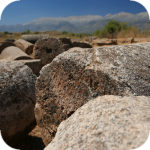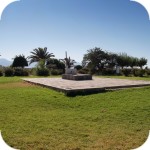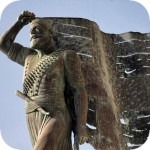
[read previous >> History of Crete from Paleolithic to Dark Ages]
[read previous >> History of Crete from the classical era to the first years of freedom]
(1941-1944)
The Second World War also impresses its mark here. In 1941, German air force attacks the island, and despite the enormous resistance of the population and allied troops, the German forces occupy Crete within a few days. Landing in Crete (Operation Mercury) was the largest airborne operation of German troops during World War II. It aimed to destroy the British forces and take strategically important - due to its central location in the Eastern Mediterranean - Crete.
Hitler believed that the Greek island could potentially be very dangerous if left under the control of the British and finally released on April 25th Directive No. 28, in which he ordered to take over Crete by means of an airborne operation.
On May 20, 8,000 paratroopers were thrown into the island, but they encountered the fierce resistance of the Allies (the so-called "Creforce") who, thanks to breaking the "Enigma" cipher, were perfectly informed about German plans. During the first few days of the battle, thousands of German paratroopers died, and only the inefficiency of the "Creforce" command and the total air advantage possessed by the Luftwaffe finally allowed the Germans to tip the scales of victory to their side. Hitler, shocked by the size of the losses, then never allowed any airborne operation, albeit similar to the landing in Crete.
Despite the enormous losses suffered, the Germans advanced, pushing the Allies further and further east towards Chania, where - in the Suda Bay - there was the only safe port of the British fleet. From there, too, from Sfakia on the southern coast, the last branches of the allies in the number of almost 15,000 people evacuated to Cyprus and Egypt.
The civilian population of Crete spontaneously joined the fighting with the Germans. Armed with old rifles (sometimes remembering the times of the anti-Turkish uprising of 1895), forks, axes, and knives, the Cretans captured and killed individual German paratroopers.
Among German soldiers, rumors of torture and cruel killing by the Cretans of wounded and captive paratroopers began to circulate.
These rumors also reached Berlin, where Hermann Göring ordered the use of "the most severe retaliatory steps", including the murder of all male Cretans or their deportation. The effects of German revenge were the first to be felt by the inhabitants of Kastelli, where the Germans shot 200 hostages on May 24.
Repression on a large scale, however, began only at the beginning of June 1941, and the symbol of German atrocities committed on the island became the fate of the villages of Kandanos and Kondomari.
In the place of the village of Kandanos, after the murdering of all inhabitants, animals and arson, the farms left a plaque with the inscription in Greek and German, proclaiming: "In revenge for the bestial murder of German paratroopers, sappers and mountain riflemen by local men, women and children with their priest and for resisting the Great German Reich, Kandanos was destroyed on June 3, 1941. This village will never be rebuilt. "
Until the liberation of the island in May 1945, 3474 inhabitants of Crete were killed by German hands, which was one of the most severely experienced regions of Greece experienced by the German occupation. The response of the Cretans to Nazi terror was the creation of a strong guerrilla movement, which in time limited German rule on the island to only the largest cities.
(1944-1967)
Even before the end of World War II, the Greek Civil War breaks out. For 5 years, the Allies supported the national-monarchist guerrilla, murdering supporters of the communist movement. It was not until 1975 that the amnesty of the last partisans hiding in the vicinity of Sfakia on Crete was announced.
In 1952, Greece joins NATO, while soldiers from the American VI Fleet start stationing in Crete.
(1967-1974)
In 1971, the capital of Crete, from Chania to Heraklion, was transferred, which has been fulfilling this role to this day. Another political crisis began in 1965, when a left-wing conspiracy was detected in the army, aimed at the withdrawal of Greece from NATO and the withdrawal of NATO-equipped NATO nuclear weapons from the country. Such a policy did not find recognition in the eyes of the monarch and the majority of officers who, on April 21, 1967, led to a coup. After the seizure of power, the country experienced repression, introduced a state of emergency, imprisoned over 45,000 people, introduced censorship (even a list of writers whose works can not be published was established, including William Shakespeare, Aristophanes or Anton Chekhov) and disallowed political parties. The purge touched the army, police and administration. Brides and mini skirts are forbidden to wear. The next military government wanted to quickly gain recognition and popularity among the Greeks, so he tried to join Cyprus in Greece in 1974 by making a coup d'état. The plans of the junta were thwarted by the rapid reaction of Turkey, which invaded the island and forced the escape of 180,000 Cypriots of Greek descent. It was a "nail to the coffin" of the dictatorship of the "black colonels." After this period in Greece, a referendum was held in which more than 70% of Greeks were in favor of maintaining the republican system.
(from 1974)
After the overthrow of the junta in Greece, democratic governments followed, and Crete began to experience a rapid development of tourism, which, apart from agriculture, became the most important source of income for the Cretans. Crete is developing more dynamically than other regions of Greece.
It is worth mentioning that the years of Arab rule and perennial disputes with Turkey still affect the shape of Greek policy, which spends a lot of its financial resources (also those received in 2010 from the EU as part of help to fight the country's crisis) on armaments. Only on Crete itself, there are currently several dozen F16s in the NATO military base on the Akrotiri peninsula (more than Poland owns).
[read previous >> History of Crete from Paleolithic to Dark Ages]
[read previous >> History of Crete from the classical era to the first years of freedom]

The history of Crete from the classical period to the first years of freedom. The increasing significance of Athens causes a drastic reduction in the political and cult role of Crete. In 67 BC, the island gets into the hands of the Romans, who are beginning to introduce their orders. Gortyna becomes the capital of the Roman province called Crete-Kyrene. The Romans are building infrastructure: roads, aqueducts, temples and theaters. Agriculture and culture are developing. All of Greece at this time becomes a Roman province, although its rich culture begins to influence the achievements of the Romans

Crete has always had a special place in the heart of Nikos Kazantsakis. Born on February 18, 1885 in Heraklion, thanks to the care of his parents, he came a long way to becoming one of the most important writers of contemporary Greek literature. Always faithful to his passions and beliefs, he rarely counted on the opinions of other people. In his life, he pointed to dreams and journeys as one of the greatest inspirations, which in 1957 contributed to the fact that the history of his life and work ended.

The Greek flag which flutter on December 1, 1913 above the fortress of Frikas in Chania, was a tangible proof of how strong ties link Crete to continental Greece. Despite hundreds of years of dependence on other superpowers, the Cretans never gave up their culture and their traditions.
Komentarze
SUPER
Jak się cieszę, że mogłam tu znaleźć tak wiele przydatnych informacji !!
Pozdrawiam ;)
Dziękuję
Dziękuję za tak wiele przydatnych informacji
Wypełnij poniższy formularz aby dodać komentarz